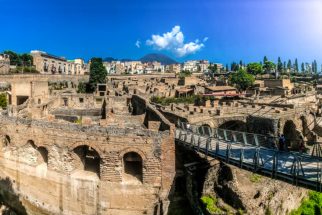Nestled at the foot of Mount Vesuvius, Ercolano is a captivating Italian city steeped in history and natural beauty. It is renowned for the ancient city of Herculaneum, preserved under volcanic ash after Vesuvius’s historic eruption in 79 AD. Today, Ercolano offers visitors a unique glimpse into the past through its well-preserved archaeological sites, complemented by picturesque views of the Bay of Naples. The city’s rich heritage and stunning scenery make it an essential stop for history enthusiasts and nature lovers alike.
For the best experience, visit Ercolano during the early spring or late autumn to avoid the summer crowds and enjoy mild weather.
Don’t miss the chance to explore the lesser-known Villa dei Papiri, a grand villa buried alongside Herculaneum, offering insight into ancient Roman lifestyles.
Top things to do & see in Ercolano
Select the following sights and activities to discover best tickets and tours available in Ercolano.
Ercolano: A Gateway to Ancient History
| Country | Italy |
| Time in Ercolano | GMT+1 |
| Language spoken | Italian |
| Population | 53,000 (2023 estimate) |
| Currency | Euro (€, EUR) |
| Airports | Naples International Airport (7 mi / 11 km). |
Ercolano, a charming town in Italy, is steeped in history and culture. Located in the shadows of Mount Vesuvius, this small town was once a thriving city of the ancient Roman Empire. Today, Ercolano is best known for its extraordinary archaeological site, Herculaneum. Buried under volcanic ash after the eruption of Vesuvius in AD 79, Herculaneum offers a remarkably well-preserved snapshot of ancient Roman life. Visitors to Ercolano can explore old streets, houses, and public buildings, remarkably preserved under layers of ash. The town is also known for its scenic beauty and proximity to Naples, making it a popular destination for tourists wishing to explore the rich cultural history and vibrant life of this region. Apart from its historical significance, Ercolano boasts lush vineyards and traditional Italian eateries, where guests can taste local wines and exquisite Neapolitan cuisine.
Where is Ercolano?
Ercolano is located in southern Italy, nestled at the base of Mount Vesuvius, near the vibrant city of Naples.
Distances:
| Route | Distance by Car | Time by Car |
|---|---|---|
| Naples to Ercolano | 8 mi (13 km) | 25 minutes |
| Rome to Ercolano | 140 mi (225 km) | 2 hours 20 minutes |
| Florence to Ercolano | 320 mi (515 km) | 5 hours |
What is Ercolano famous for?
Ercolano is renowned for the well-preserved ruins of Herculaneum, which provides an invaluable look into the life of ancient Romans before the devastation caused by the eruption of Mount Vesuvius.
History
Ancient Times
Originally known as Herculaneum, Ercolano’s history dates back to the 6th-7th centuries BC when it was likely founded by the Osci, an ancient people of Campania. Flourishing as a Roman town, it became a residential area for the Roman elite, who built elaborate villas with panoramic views of the Bay of Naples and Mount Vesuvius.
79 AD – The Catastrophe
On August 24, 79 AD, Mount Vesuvius erupted catastrophically, burying Ercolano under an avalanche of volcanic ash and mud. This resulted in the preservation of much of the city’s structures and artefacts, encapsulating day-to-day life in a Roman city. [/p>
Post-Eruption and Rediscovery
The town was lost to memory until its rediscovery in 1709 by workers digging a well. Archaeological excavations began sporadically in the mid-18th century under the patronage of the Bourbon kings and have continued, with various interruptions, to the present day. These excavations have provided invaluable insights into Roman urban life, architecture, and society.
Modern Era
In contemporary times, Ercolano has been subject to both the challenges and benefits of its archaeological heritage. Development is tightly controlled to prevent damage to ancient remains, yet the town benefits from tourism and ongoing archaeological research. The modern city coexists with its ancient counterpart, providing a unique window into the past.
Visit Ercolano
What to see and do in Ercolano
Visitors to Ercolano can explore the well-preserved ruins of the ancient city of Herculaneum, where structures such as homes, stores, and public baths provide a glimpse into ancient Roman life. The site features remarkably preserved wooden objects, mosaics, and frescoes.
- Explore the ancient ruins at the Herculaneum archaeological site.
- Visit the MAV (Virtual Archaeological Museum), offering a high-tech, multimedia experience of the city’s history.
- Stroll through the lush gardens and experience panoramic views at Villa Campolieto.
- Enjoy the local cuisine and wines in traditional restaurants and cafes.
Festivals and Events in Ercolano
Ercolano hosts a variety of cultural events and festivals throughout the year, the most notable being the Festival of Saint Januarius (San Gennaro) which generally occurs in September. The festival features religious processions, fireworks, and local cuisine, drawing both locals and tourists.
Best time to visit Ercolano
The best time to visit Ercolano is during spring (April to June) or fall (September to October), when the weather is pleasant, and the tourist crowds are less dense compared to the high summer months.
Is Ercolano worth visiting?
Ercolano is undeniably worth visiting for those interested in history and archaeology. Its well-preserved ruins offer a deep dive into ancient Roman life, dramatically encapsulated by the eruption of Mount Vesuvius. Beyond the archaeological site, Ercolano is rich in beautiful vistas, cultural experiences, and traditional Italian hospitality, making it a compelling destination for diverse travelers.










